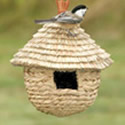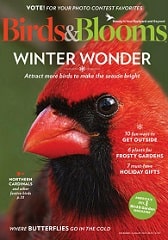Carolina Wren: Not Your Regular Jenny Bird
This guide to the Carolina Wren covers everything from its nesting habits and diet to its distinctive song and year-round behaviors.
The state bird of SC, these birds are common east of the Rocky Mountains and do not migrate in the traditional sense. More about that later.
Description: Size, Field Marks
Carolina Wrens measure 5 1/2 to 6 inches in length with warm brown upperparts and buff-tinged underparts.
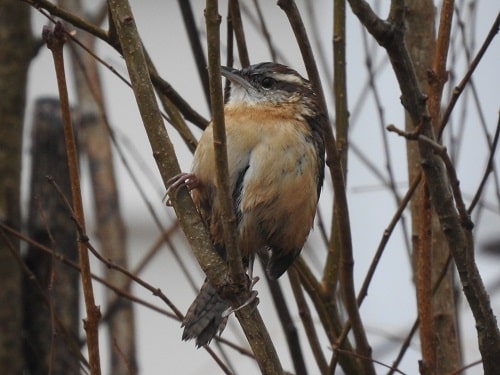
Adult Carolina Wren
The most prominent features that identify this bird is its bold white eyebrow, white chin, and no streaking on the back.
The white line eyebrow is helpful in correct identification. This is an easy way to distinguish it from the House Wren.
Nesting Habits: Building Materials, Location
Carolina Wrens make a domed, cup-shaped nest made of twigs, grass, and bark. The inside is lined with fine materials.
The distinctive side entrance seen in the picture below is very helpful in identifying the nest from other bird's nests.
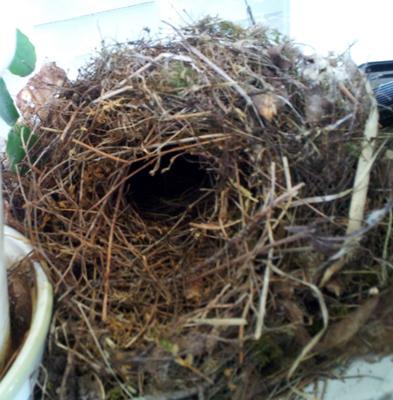
What a Carolina Wren Nest Looks Like
Located anywhere from 1 to 10 feet above the ground, the nests can be found in almost anything.
You'll find the nests in tree cavities, propane tank lids, BBQs, and man-made birdhouses. As a matter of fact, there are a lot of strange places they've nested, even mailboxes!
Both males and females participate in nest building.
What Month Do They Lay Eggs?
Egg laying for Carolina Wrens can begin as early as March in the southern states and April in more nothern states.
Second and third broods can be started as late as June.
| Carolina Wren Breeding Information | |
|---|---|
| Eggs | 4 - 8 |
| Incubation | 12 - 14 days |
| Nestling Phase | 12- 14 days |
| Broods | 2 - 3 |
Incubation: When do Carolina Wrens Eggs to Hatch?
The female lays 4 - 8 eggs that are creamy or pink-white with brown marks.
Incubation is done by the female and begins after the last egg is laid.
It will take 12 - 14 days of incubation before the Carolina Wrens eggs hatch.
The male will feed the female while she incubates the eggs. Sometimes the male will call and the female will go to the male for food.
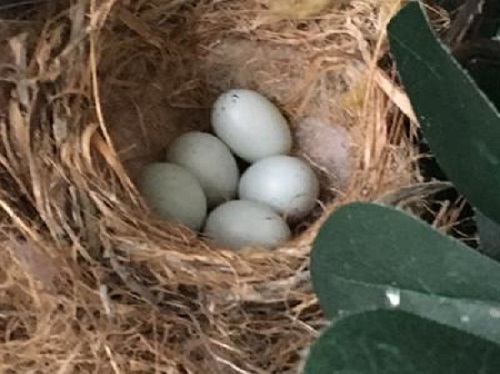
Five Carolina Wren Eggs
Song - Call: What They Mean
Its call of tea-kettle, tea-kettle, tea-kettle, Chirrrrrr is well known by friends of this bird. Often you'll hear this bird before you see it.
In the audio above you'll hear the common tweedle, tweedle, tweedle, song which is used for announcing territory and for attracting a mate.
The second sound is the rasping call which is used to warn intruders who are getting too close.
Mating Breeding Habits
Carolina Wren Singing
Pairs may form at any time during the year but primarily do so in the Fall.
Carolina Wrens mate for life and can be seen traveling together throughout their feeding and nesting territory.
When Wren Babies Fledge (Leave Nest)
The chicks will leave the nest in 12 -14 days after hatching.
When the young are due to fledge, the adults will make several trips to the nest with no food. This encourages the young to leave the nest.
2 or 3 broods are raised each season. The breeding season runs from April to July. Southern birds may begin nesting in March.
Carolina Wrens do not reuse old nests, but they may build new nests in the same area as a previous one.
Often the female will stay in the nest rather than take flight when someone approaches the nest.
This is about protecting the eggs more than being unafraid. Too much human activity may cause nest abandonment.
What do They Eat: Summer-Winter Diets?
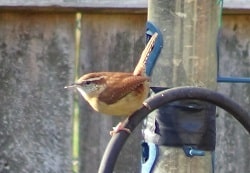
Carolina Wren Eating Suet in Winter
Carolina Wrens are most commonly seen foraging on the ground, tossing leaf litter aside, and looking for their primary food, insects.
Some of the insects they're looking for are crickets, grasshoppers, leafhoppers, caterpillars, moths and chinch bugs.
You can also find them feeding along downed limbs or climbing the trunks of trees and inserting their bill in the bark in search of food.
Tell us all about the Wrens nesting around you.
Make sure you get a photo or two.
Then Follow the link below.
Share Your Story Here.
Read What Other Visitors Have Shared
Read Stories
Winter Behavior and Migration
| As an Amazon Associate, wild-bird-watching earns from qualifying purchases. See our Privacy Policy |
While a permanant resident in its range, the Carolina Wren has an unusual winter habit.
Some younger birds travel farther northward for unknown reasons, and set up new territories for nesting.
Currently, its breeding range is as far north as Wisconsin, Minnesota, and southern New England.
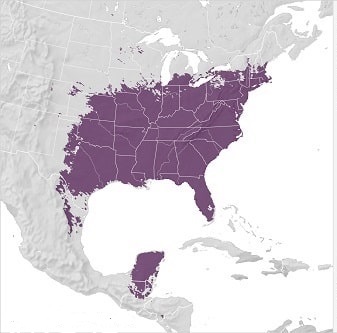
Carolina Wren Range Map
As long as winters are mild, these young birds will build resident populations.
If winter becomes severe, resulting in food shortages, these birds will perish by not moving south.
This northward cycle would then be repeated over time.
Carolina Wrens visit my feeders here in Kansas all winter long. In winter, these Wrens will eat sunflower heart chips.
I also provide safflower seed and suet for them to eat. It's an important supplement to their diet as it adds fat that helps in winter.
A Heated Birdbath can help provide drinking and bathing water in both summer and winter.
Video of Carolina Wren at Birdfeeder
Carolina Wren Feeding on Insects
Selecting Seeds Out of Shell
Watch Videos of Carolina Wrens
Credits
Dunne, P. (2006). Pete Dunne's essential field guide companion. Houghton Mifflin Harcourt, New York, USA.
Hill Collins, Jr., H., N. Boyajian. 1965. Familiar Garden Birds of America. New York: Harper & Row, Publishers, Inc.
September194X Vol. 60, No. 3 THE WILSON BULLETIN 139 A NESTING OF THE CAROLINA WREN Sora UNM.edu
